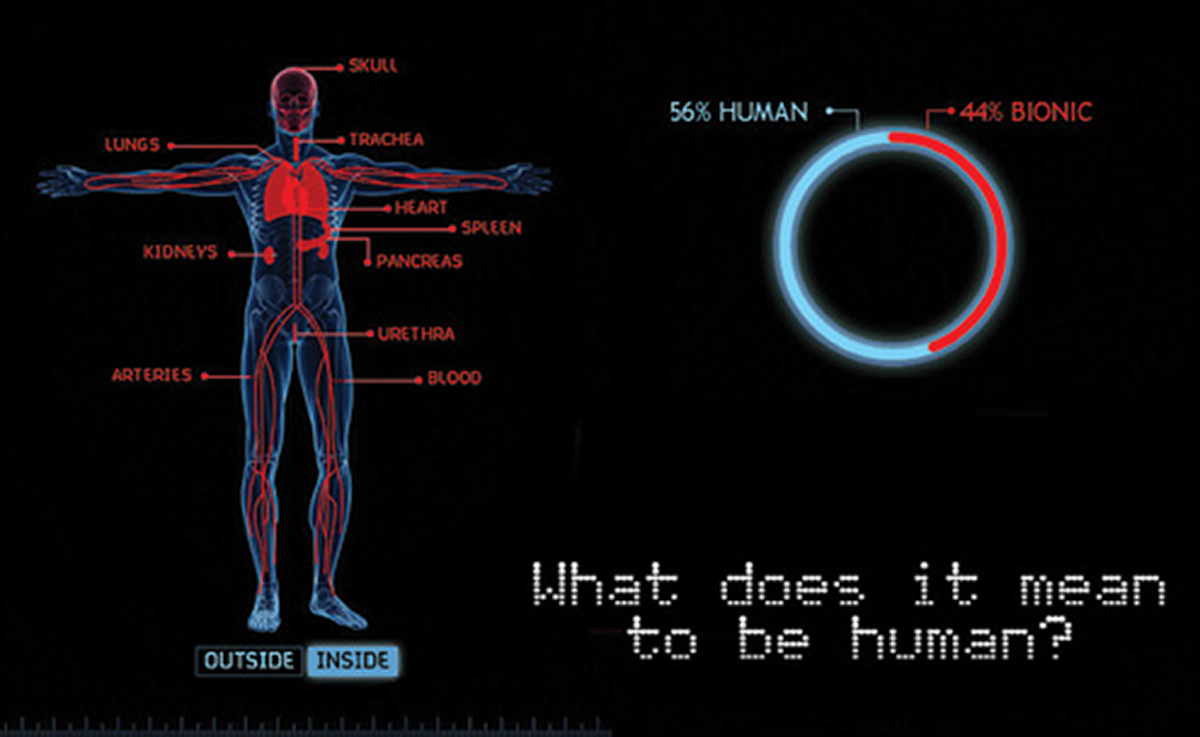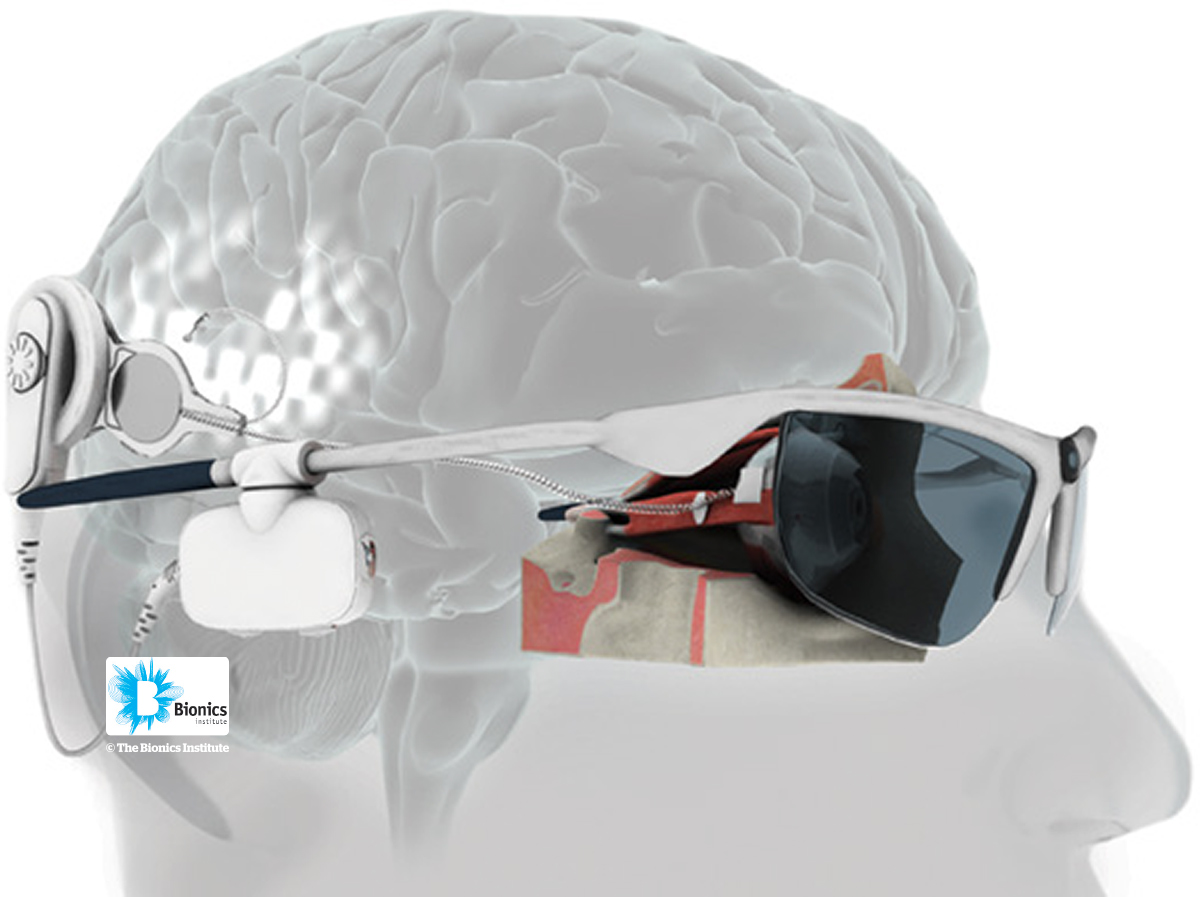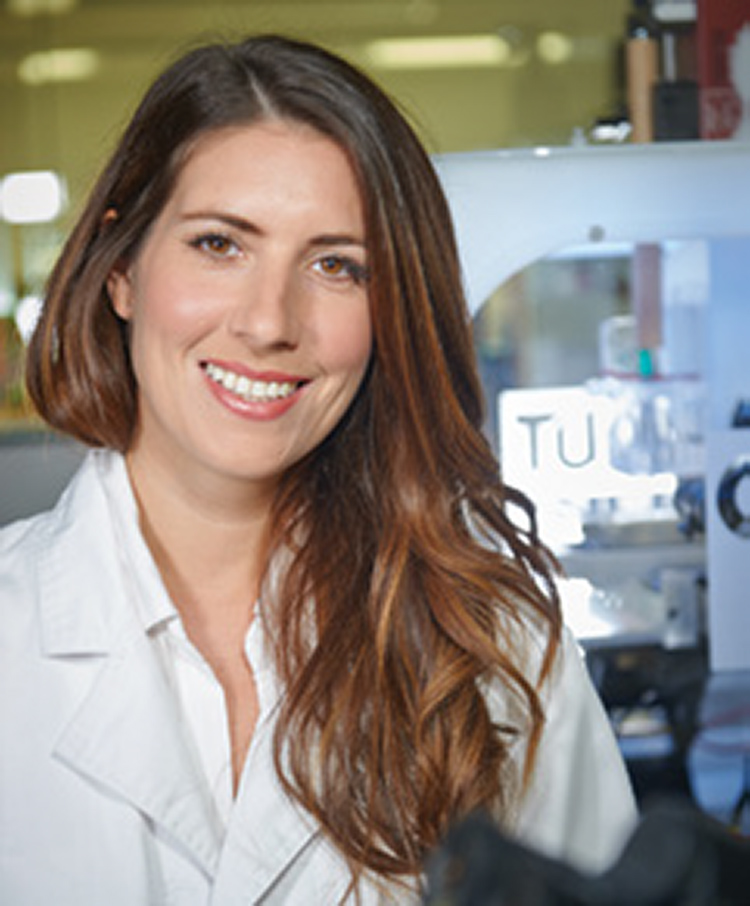G20 Executive Talk Series
Human Bionics
THOUGHT LEADERSHIP
Human Bionics
THOUGHT LEADERSHIP
Authored by: Dr Robyn Stokes
Converging technologies and human bionics:
A future where no one is ‘left behind’
Australia’s human bionics interface alliance is gaining momentum, inviting and stimulating new scientific and commercial partnerships.
Bionic Eye
Futurist and bestselling author, Ray Kurzweil speaks of 20,000 years of progress happening this 21st Century…and it’s not just possible, it’s probable. Exponential growth in technology made possible by the Internet of Things (IOT) is set to deliver extraordinary shifts via big data analytics, artificial intelligence and robotics and in turn, unstoppable changes in global health care. While there are ethical and practical questions (‘do we need a new definition of what it is to be human?’ and ‘will we work well with our robotic colleagues?’), a convergence of technologies will transform our everyday lives and health in ways we can barely imagine. Ignoring change may look like a safe, albeit unadventurous haven, but it is not an option. Breakthroughs in deep learning, robotics, digital biology, nanotechnology, neuroscience, bionics and additive manufacturing are converging and it is time for ‘moon shot thinking’ on what this will mean for humanity. What are the seemingly impossible problems that we will solve as humans and artificial intelligence collide? What are the step-wise changes in the design and delivery of healthcare solutions and changes in the way we manage global health that these converging technologies will bring?
Germany has given the issue of global health ‘top billing’ during this year’s G20. The 2017 program of G20 meetings has overtly recognised the responsibility of the Group of 20 for human health as a pre-condition to development. Respecting the UN concept of universal health coverage and the 2030 Agenda Principle of ‘leaving no one behind’, 2017 is a landmark year of G20 deliberations on health. For G20 leaders, strengthening public health systems and universal access are high priorities along with achieving a better understanding of social, environmental and economic determinants of health and disease. Equally important though in managing change are robust strategies for surveillance of global health issues and greater collaboration and information sharing on technological change. With the risk of pandemics and anti-microbial resistance, crisis preparedness for global health emergencies is a number one priority. However, technology-driven collaboration on healthcare is arguably a key plank in crisis preparedness and at the same time, a powerful way to develop breakthrough healthcare solutions.

A Monash Cortical Electrode array or ‘tile’ for the cortical bionic eye. Multiple tiles can be placed in the visual cortex of the brain.
In particular, this century’s fourth industrial revolution (the Internet of Things) will bring many new breakthroughs in human bionics with new smart devices, bionic organs and limbs, bio-fabricated body parts and advanced prosthetics enabling those with complex disabilities to live an ordinary life. For Australia’s Dr Dimity Dornan, AO, founder of Hear and Say (globally acclaimed for teaching children to hear and speak using the bionic ear), converging technologies and digital healthcare hubs are key infrastructure to realise her wider vision for human bionics. During last year’s G20 in China, Dr Dornan highlighted the tsunami of human bionics breakthroughs that the marriage of nanotechnology (‘nano’), neuroscience (‘neuro’) and bionics (‘bio’) could bring and this year her plans for vertical and horizontal collaboration (bringing patients, scientists, entrepreneurs and investors together) are gathering speed.
![]() In Dr Dornan’s words, healthcare needs are “highly complex and this brings the need for rich inter-connectivity (of science and technologies) to develop successful bionics devices, organs and limbs.
In Dr Dornan’s words, healthcare needs are “highly complex and this brings the need for rich inter-connectivity (of science and technologies) to develop successful bionics devices, organs and limbs. ![]()
An advocate for greater entrepreneurialism and investment in human bionics and accelerated partnerships to commercialise new devices and breakthroughs, Dr Dornan has created a new organisation, Human Bionics Interface, to accelerate solutions for the millions of people who live with untreatable physical conditions including missing or diseased limbs and organs. With exponential changes in technology, the bionic man or woman is no longer science fiction. In 2017, medical scientists, inventors and technologists are augmenting and enhancing the function of many organs and limbs and achieving astounding results with functionality and movement.
Especially exciting advances and new opportunities for bionic solutions exist in hearing and vestibular systems, in vision with the bionic eye and improved optogenetics in bio-fabrication and prosthetics (creating and augmenting body parts and limbs), in neuromodulation and neuroplasticity, deep brain stimulation and many other areas. Brain mapping brings with it the promise of even greater things to come. Neural prostheses already make it possible for nerve messages to be transmitted from the brain to the hand.
Australia has already developed and commercialised a number of ‘firsts’ in medical science starting with the Cochlear implant (bionic ear). More recent science and medtech relationships have also led to ground breaking work on artificial organs e.g. the bladder, pancreas, lungs and kidneys. In 2017, the Australian-invented ‘Evoke’ spinal cord system is nearing commercialisation. Evoke will provide the first true, closed-loop neuro-modulation system enabling electric impulses to stimulate the spinal cord to mask or interrupt pain signals. In recent months, Bionic Vision Australia (BVT) has also received US$18m in funding for a further clinical trial of a next generation bionic eye and its commercialisation. Technology from the Melbourne-based Bionics Institute, the clinical expertise of the Centre for Eye Research Australia and vision processing software of Data 61 underpin this exciting commercial venture.

Dr Dimity Dornan, AO, Founder of Hear and Say and the Human Bionics Interface alliance
According to Dr Dornan, the ‘star gates’ to the future in human bionics lie in understanding the brain and ‘befriending’ the complex links between thought, action and human response. “Powerful results in the decade ahead will come from brain mapping work already happening in the United States, Australia and China and from the mass participation of health consumers (individuals from all walks of life) already using digital avenues such as social media to involve themselves in a shared search for ‘tailor-made’ bionics solutions. Further advances in thought activation software will enable the brain to connect with an even wider array of complex bionics devices. Australian life sciences entrepreneur and advisor, Dr Peter Riddles sums up the opportunity: “For millennia, human beings have interacted with machines, albeit remotely to achieve things that would not otherwise be possible. Going forward, bionics will enable ‘machines’ to become more personal and connected, enabling all people to realise their greater potential.”
Dr Dornan says her focus in a Phase 1 Action Plan for Australia’s Human Bionics Interface is complex disabilities (linked to hearing, vision, movement and a range of so far untreatable conditions) and ways that the ‘big data’ value chain in global healthcare can unleash new partnerships to speed up the commercialisation of bionics devices. Linking key players in Australia’s healthcare ecosystem and medtech community with global tech giants such as IBM and Google are in sight along with new levels of cooperation across geographic boundaries. Much greater collaboration will be needed between bionics users, scientists and inventors and for this reason; the real game changers will be digital health tech hubs across continents and within these hubs, digital healthcare platforms.

In Dr Dornan’s words, healthcare needs are “highly complex and this brings the need for rich inter-connectivity (of science and technologies) to develop successful bionics devices, organs and limbs. The challenge is twofold….firstly, to comprehensively tap big data on the needs of health care users and their clinicians and create new multi-disciplinary knowledge banks and secondly, to synthesise and respond to that knowledge with advanced bionics solutions that combine powerful, but fragmented technologies”.
There is no doubt that new digital health platforms (and even greater participation in social media) will see consumers getting very hands-on, working directly with experts in the virtual world to co-create solutions to complex health issues. In ‘Healthcare Reimagined’, Ernst and Young speak of a new participatory health ecosystem, a profound and disruptive change in the patient-doctor relationship and a change in the patient-scientist-manufacturer relationship that has the capacity to transform the lives of many people living with disabilities.

A schemata of Australia’s next generation bionic eye now undergoing clinical trials in advance of commercialisation.
Dr Dornan says the Human Bionics Interface alliance aims to “bust the silos and bring change-makers together in the physical and virtual world to accelerate solutions. Australians are outgoing by nature and the drive to form new partnerships in human bionics is palpable. While it is early days, we are facilitating new partnerships and seeing more bionic technology inventions in the marketplace – it is only through commercial release that the world’s bionics discoveries and new devices can help those with disabilities in developed and developing nations. This is not just a goal for Australia, but rather a goal for multi-lateral partnerships”.
“We have a vibrant network of human bionics ‘change makers’ in Australia with a new Bio-Fabrication Institute at the Herston Health Precinct in Brisbane, Queensland; a well-established Bionics Institute in Melbourne, Victoria that is set to commercialise the next generation bionic eye; a burgeoning medtech cluster in South Australia and ground-breaking research occurring Australian universities”, she said.
Dr Dornan describes the new Herston Biofabrication Institute in Brisbane (a collaboration between Queensland University of Technology and Metro North Hospital and Health Service) as especially unique. The Biofabrication Institute will be a space where doctors and researchers are able to develop techniques to engineer new tissue using advanced clinical scanning, modelling and 3D printing. It will focus on developing biofabrication in three key areas: 3D imaging, 3D computer modelling and visualisation and 3D cell culture and 3D bio-printing to create customised engineered tissue implants, some using the patient’s own cells.
Importantly, this will be the first time that a bio manufacturing institute has been co-located with a high-level Australian hospital, in this case the Royal Brisbane and Women’s Hospital on the Herston precinct, one of the largest health precincts in Australia. The new facility is set to catapult Queensland onto the global stage providing exciting opportunities for scientists and clinicians to be employed in cutting-edge research and attract significant private sector and philanthropic investment. Associate Professor Mia Woodruff from QUT’s Institute of Health and Biomedical Innovation has tipped the Institute to become “a world leader in tissue regeneration attracting $10-15 million (Australian dollars) each year”. She says the Institute will also serve as an education hub for STEM disciplines and lead to the development of next-generation robotic surgery and bionics through close working relationships with industry partners.

Associate Professor Mia Woodruff of the new Biofabrication Institute at the Herston Health Precinct in Brisbane, Australia.
Australia’s G20 in 2014 saw the first G20 Global Café and the inaugural Innovation 20 held in Brisbane, Queensland alongside the G20 Leaders’ Summit. These events paved the way for an exciting new international dialogue between scientists, clinicians, inventors, the start-up world and corporate investors. A robust dialogue ensued on technology-enabled change and new disrupted business models that extended to the life sciences, medtech and the field of human bionics. Subsequently, the China G20 led to further engagement on innovation and a meeting of international brain mapping specialists.
Australia’s G20 presidency meeting has continued to have flow-on effects for science and for major scientific events. Brisbane’s success in hosting the G20 Leaders’ Summit and the G20 Global Café were pivotal factors in Brisbane securing a multi-year contract to stage the highly acclaimed World Science Festival. In 2017, this Festival attracted scientific luminaries from across the globe that headlined performances, debates and scientific demonstrations while innovators across the scientific spectrum shared their knowledge at a range of events. The Festival brought $5.1 million into the Queensland economy in 2016 and the attendance of over 180,000 people has brought even higher economic returns to the state this year. Professor Suzanne Miller, Queensland’s new Chief Scientist and CEO of the Queensland Museum who negotiated to bring the World Science Festival to Australia sees human bionics as “a vital area of scientific endeavour in Australia, a fertile ground for new public-private partnerships and an arena where further entrepreneurialism and commercialisation will occur”.
Next year, the state of Queensland will again play host to an international dialogue on innovation (including human bionics breakthroughs) at a Commonwealth Innovation Forum held alongside the Gold Coast 2018 Commonwealth Games (GC2018). Mario Pennisi, head of Life Sciences Queensland and founder of the Innovation 20, will spearhead the Commonwealth Innovation Forum, a dynamic event he says is designed to “explore life sciences innovations that will help to feed, fuel and heal the world’s people living in Commonwealth nations and beyond. Human bionics innovations are especially topical in the world of sport with many flow-on benefits for technology-enabled sports participation”.
![]() Going forward, bionics will enable ‘machines’ to become more personal and connected, enabling all people to realise their greater potential.
Going forward, bionics will enable ‘machines’ to become more personal and connected, enabling all people to realise their greater potential. ![]()
Dr Dornan, as the founder of Human Bionics Interface, sees even greater opportunities for Australia and other G20 nations arising from the renewed focus on global health by G20 leaders. According to Dr Dornan, G20 meetings in the ‘Development Track’ can serve to highlight the importance of continued collaboration on technology enabled healthcare including human bionics.
“This is a life science domain where much can be achieved on the UN goal of ‘leaving no one behind’. Greater access to the bionic ear and with that, the ability for more people to hear and speak in developing nations and, in time, access to the bionic eye and other technology enabled health solutions among impoverished people will redefine life’s opportunities. While the challenges are immense for developing nations, even low level engagement in digital hubs for health innovation will augur well for those who would otherwise be ‘left behind’.
With exponential shifts in technology, Dr Dornan sees students and scientists in developed and developing nations becoming active contributors to human bionics innovations and gaining direct benefits from the dialogue and inventions that emerge from digital healthcare hubs. Forward strategies of the Human Bionics Interface organisation led by Dr Dornan will focus directly on achieving greater horizontal and vertical collaboration (via real world events and digital platforms), boosting entrepreneurialism, stimulating cross-border innovation and encouraging faster commercialisation of bionics devices.
For further information on membership or involvement in Human Bionics Interface, contact Dr Dimity Dornan at: dimity.dornan@hearandsay.com.au
Dr Robyn Stokes is an Australian business strategist and foundation member of Bionics Queensland. Twitter: @brisrobyn